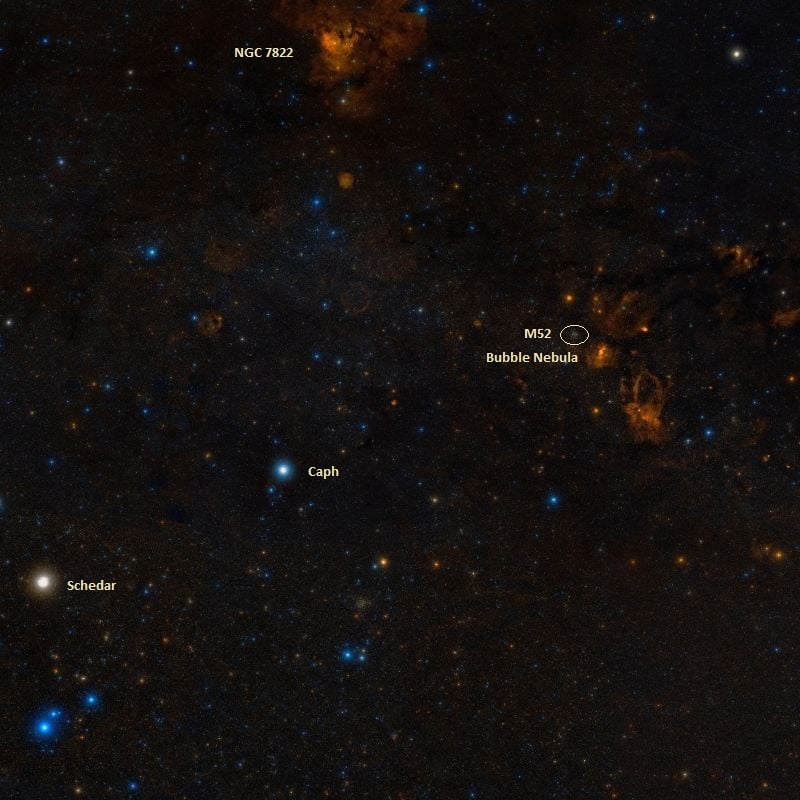Welcome back to Messier Monday! We continue our tribute to our dear friend, Tammy Plotner, by looking at the open star cluster of Messier 52. Enjoy!
In the 18th century, while searching the night sky for comets, French astronomer Charles Messier kept noting the presence of fixed, diffuse objects in the night sky. In time, he would come to compile a list of approximately 100 of these objects, with the purpose of making sure that astronomers did not mistake them for comets. However, this list – known as the
Messier Catalog
– would go on to serve a more important function.
One of these objects is Messier 52, an open star cluster that can seen in proximity to the northern constellation
Cassiopeia
. Located about 5000 light years from Earth, this star cluster is easily spotted in the night sky because of its association with Cassiopeia's familiar W-shape. It can viewed with binocular and telescopes, and will appears as a hazy, nebulous patch of light.
Description:
Located roughly 5000 light years away, this 35 million year old cluster of stars has around 200 members - one of which is a very peculiar Of star. According to A.K. Pandy (et al), M52 is an interesting cluster in which to study star formation history. As they stated in their
2001 study
:
[caption id="attachment_136637" align="aligncenter" width="580"]
The Messier 52 open star cluster. Credit: Wikisky
[/caption]
Indeed, M52 has been very studied for its star structure, including a search for variables. As S.L. Kim (et al), wrote in a
2000 study
:
And it's not just the structure they're looking at - but the time frame in which they formed. As Anil K. Pandey wrote in her
2001 study
:
History of Observation:
M52 was an original discovery of Charles Messier, captured on the night of September 7th, 1774. As he wrote in his notes at the time:
[caption id="attachment_136635" align="aligncenter" width="580"]
Atlas Image mosaic of Messier 52, as part of the Two Micron All Sky Survey (2MASS). Credit: UMass/UPAC/Caltech/NASA/NSF
[/caption]
Sir William Herschel would also observe M52, but he would keep his notes private. As he wrote on August 29th, 1873:
Herschel's son John would also add it to the General Catalog a few years later with less descriptive narrative, but it was Admiral Smyth who described M52's beauty best when he said:
May it glitter and spangle for you!
[caption id="attachment_136638" align="aligncenter" width="580"]
The location of Messier 52 in proximity to the constellation Cassiopeia. Credit: IAU and Sky & Telescope magazine (Roger Sinnott & Rick Fienberg)
[/caption]
Locating Messier 52:
In the rich star cluster fields of Cassiopeia, M52 is distinctive for its size and brightness. It's not hard to find! Begin by identifying the W-shape of Cassiopeia and focus on its two brightest stars - Alpha and Beta. Because this constellation is circumpolar, remembering to look at the side that has the brightest stars or the steepest angle, will help you remember how to find this great open cluster. Now, just draw a mental line between Alpha, the lower star, and Beta, the upper.
Extend that line into space about the same distance and aim your binoculars or finderscope there. In binoculars M52 will show clearly as a beginning to resolve star cloud and a hazy patch in a telescope finderscope. Even the smallest of telescopes can expect resolution from this multi-magnitude beauty and the more aperture you apply, the more stars you will see. M52 is well suited to urban or light polluted skies and stands up well to fairly moonlit conditions and hazy skies.
- Object Name
-
Messier 52
- Alternative Designations
-
M52, NGC 7654
- Object Type
-
Open Galactic Star Cluster
- Constellation
-
Cassiopeia
- Right Ascension
-
23 : 24.2 (h:m)
- Declination
-
+61 : 35 (deg:m)
- Distance
-
5.0 (kly)
- Visual Brightness
-
7.3 (mag)
- Apparent Dimension
-
13.0 (arc min)
We have written many interesting articles about Messier Objects here at Universe Today. Here's Tammy Plotner's
Introduction to the Messier Objects
,
M1 – The Crab Nebula
, and David Dickison's articles on the
2013
and
2014
Messier Marathons.
Be to sure to check out our complete
Messier Catalog
. And for more information, check out the
SEDS Messier Database
.
Sources:
- *Messier Objects - Messier 52*
- Wikipedia - Messier 52
- SEDS - Messier 52
 Universe Today
Universe Today
